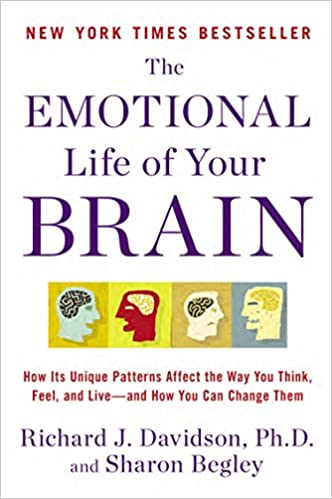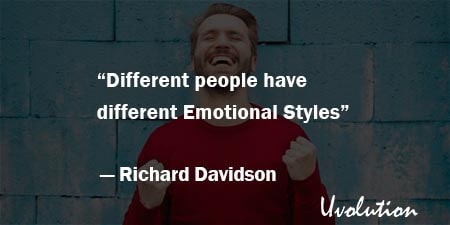The Emotional Life of Your Brain by Richard Davidson
The Book in 1 Sentences
"Why and how do people differ so widely in their emotional responses to the ups and downs of life?
The answer that has emerged from my own work is that different people have different Emotional Styles.” ~ Richard J. Davidson
7 BIG Ideas
2. 6 Dimensions of Emotional Style
3. Brain & Emotional Styles Can Change
The Emotional Life of Your Brain Book Summary
1. Emotional Style
“Over the course of my career as a neuroscientist, I’ve seen thousands of people who share
similar backgrounds respond in dramatically different ways to the same life event.
Some are resilient in the face of stress, for instance, while others fall apart. The latter become anxious, depressed, or unable to function when they encounter adversity.
Resilient people are somehow able not only to withstand but to benefit from certain kinds of stressful events and to turn that adversity into advantage.
This, in a nutshell, is the puzzle that has driven my research. I’ve wanted to know what determines how someone reacts to a divorce, to the death of a loved one, to the loss of a job, or to any other setback—and, equally, what determines how people react to a career triumph, to winning the heart of their true love, to realizing a friend will walk over coals for them, or to other sources of happiness.
Why and how do people differ so widely in their emotional responses to the ups and downs of life?
The answer that has emerged from my own work is that different people have different Emotional Styles.”
“The smallest, most fleeting unit of emotion is an emotional state. Typically lasting only a few seconds, it tends to be triggered by an experience... A feeling that does persist, and that remains consistent over minutes or hours or even days, is a mood, of the “he’s in a bad mood” variety. And a feeling that characterizes you not for days but for years is an emotional trait.”
“Just as each person has a unique fingerprint and a unique face, each of us has a unique emotional profile, one that is so much a part of who we are that those who know us well can often predict how we will respond to an emotional challenge.”
2. 6 Dimensions of Emotional Style
“Emotional Style comprises six dimensions. Neither conventional aspects of personality nor simple emotional traits or moods, let alone diagnostic criteria for mental illness, these six dimensions reflect the discoveries of modern neuroscientific research:
• Resilience: how slowly or quickly you recover from adversity.
• Outlook: how long you are able to sustain positive emotion.
• Social Intuition: how adept you are at picking up social signals from the people around you.
• Self-Awareness: how well you perceive bodily feelings that reflect emotions.
• Sensitivity to Context: how good you are at regulating your emotional responses to take into account the context you find yourself in.
• Attention: how sharp and clear your focus is.”
“I would go so far as to assert that of all the forms of human behavior and psychological states, the most powerful influence on our physical health is our emotional life.”
3. Brain & Emotional Styles Can Change
“Although Emotional Style is ordinarily quite stable over time, it can be altered by serendipitous experiences as well as by conscious, intentional effort at any point in life, through the intentional cultivation of specific mental qualities or habits.
I am not saying that it is theoretically possible to shift your place on one of the continua of Emotional Style, or that such a shift is possible only in principle. In my research, I have discovered practical, effective ways to do so...
for now suffice it to say that you can modify your Emotional Style to improve your resilience, social intuition, sensitivity to your own internal emotional and physiological states, coping mechanisms, attention, and sense of well-being.
The amazing fact is that through mental activity alone we can intentionally change our own brains. Mental activity, ranging from meditation to cognitive-behavior therapy, can alter brain function in specific circuits, with the result that you can develop a broader awareness of social signals, a deeper sensitivity to your own feelings and bodily sensations and a more consistently positive outlook.
In short, through mental training you can alter your patterns of brain activity and the very structure of your brain in a way that will change your Emotional Style and improve your life. I believe this is the ultimate step in mind-body interaction.”
“Since the brain contains the physical underpinnings of Emotional Style, and since the brain can change in these fundamental ways, Emotional Styles can change.”
4. Our Genes Don't Determine Our Lives
“These were the first hints that our emotional and psychological fate does not lie solely within the twists of the double helix. Depending on the experience a child has had, a genetic basis for shyness, or aggression, or delinquency might or might not manifest itself.
Rather than thinking of DNA as the software running our cells—or the player-piano sheets that dictate what notes will be played—it is time to think of it as a music collection.
Whether you store your music on an iPod or as a stack of CDs or (are there any of us left?) vinyl records, what music we hear depends on which music gets played. Just because we have it doesn’t mean the harmonies encoded in the bumps and valleys within the grooves of an LP will reach our ears.
Now we know that just because we have a particular gene doesn’t mean that it’s music will be part of our lives. Or, if I may abandon the music analogy, think of it this way: Genes load the gun, but only the environment can pull the trigger.”
“In short, the revolution in neuroplasticity has shown that the brain can change as a result of two distinct inputs. It can change as a result of the experiences we have in the world—how we move and behave and what sensory signals arrive in our cortex. The brain can also change in response to purely mental activity, ranging from meditation to cognitive-behavior therapy, with the result that the activity in specific circuits can increase or decrease.”
5. Cognitive-Behavior Therapy
“Cognitive-behavior therapy, which was developed in the 1960s, is at bottom a form of mental training. It focuses on teaching patients to respond to their emotions, thoughts, and behaviors in a healthy way.
The idea is to reappraise dysfunctional thinking, helping people escape the pattern in which they think, The fact that she didn’t want to go out with me a second time means I am a total loser and will never be loved.
Patients learn to recognize their habit of catastrophizing, of turning everyday setbacks into calamities, and with these cognitive skills, they can feel sadness and experience disappointment without tumbling into the abyss of depression.”
Sonja Lyubomirsky - In her book The How of Happiness - tells us: “Write down your barrier thoughts, and then consider ways to reinterpret the situation. In the process, ask yourself questions like... What else could this situation or experience mean? Can anything good come from it? Does it present any opportunities for me? What lessons can I learn and apply to the future? Did I develop any strengths as a result?”
Sonja also says: “Essentially, all optimism strategies involve the exercise of construing the world with a more positive and charitable perspective, and many entail considering the silver lining in the cloud, identifying the door that opens as a result of one that has closed.
It takes hard work and a great deal of practice to accomplish effectively, but if you can persist at these strategies until they become habitual, the benefits could be immense. Some optimists may be born that way, but scores of optimists are made with practice.”
6. Mindfulness Meditation
“To cultivate greater Resilience and faster recovery from setbacks, I recommend mindfulness meditation. Because it produces emotional balance, mindfulness meditation helps you recover, but not too quickly (just as it helps you focus but not get hyperfocused).
Mindfulness weakens the chains of associations that keep us obsessing about and even wallowing in a setback. For instance, losing a job might cause your thoughts to tumble from “unemployment” to “no health insurance” to “lose home” to “I can’t go on.”
Mindfulness strengthens connections between the prefrontal cortex and the amygdala, promoting equanimity that will keep you from spiraling down this way.
As soon as your thoughts begin to leap from one catastrophe to the next in this chain of woe, you have the mental wherewithal to pause, observe how easily the mind does this, note that it is an interesting mental process, and resist getting drawn into the abyss.
I recommend that you start with a simple form of mindfulness meditation such as the mindfulness of breathing, described previously.”
“Mindfulness meditation carves new channels in the streambeds of the mind.”
Check the book for more practical tips on mindfulness meditation.
7. Resilience on The Little and The Big Things
“My research has consistently demonstrated that recovery from the minor challenges we administer in an experiment, such as being burned by the thermode or seeing an upsetting picture, is strongly correlated with and predictive of how someone copes with real-life adversity, particularly how quickly they recover.
Resilience on the little things is therefore a good indicator of Resilience on the bigger ones... If they recover quickly from the little setbacks, they tend to be resilient in the face of big ones, and if they become paralyzed by or obsess over the little things, they tend to be laid low for a long time by the big things, too.”
“The brain is neither immutable nor static but continuously remodeled by the lives we lead.”
“Transforming your skill in attention will require some practice, but because attention is the building block for so much else, I believe it’s worth the effort. And I’m confident that most people will experience some benefit in a short period of time.”
That was my QUICK summary of the great book The Emotional Life of Your Brain by Richard Davidson. If you’re interested, get your copy. There is a HUGE amount of life-changing ideas in this book, and we’ve only touched on a tiny bit of it.
Buy The Book: The Emotional Life of Your Brain by Richard Davidson

GET Blinkist 7 Days FREE Trial
3000+ Book Summaries
(Audio and Text)








